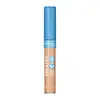What's inside
What's inside
 Key Ingredients
Key Ingredients

 Benefits
Benefits

 Concerns
Concerns

 Ingredients Side-by-side
Ingredients Side-by-side

Octyldodecanol
EmollientIsocetyl Stearoyl Stearate
EmollientIsodecyl Neopentanoate
EmollientBis-Diglyceryl Polyacyladipate-2
EmollientCandelilla Cera
EmollientDiisostearyl Malate
EmollientNeopentyl Glycol Diheptanoate
EmollientOryza Sativa Bran Wax
Skin ConditioningTriethylhexanoin
MaskingPolymethylsilsesquioxane
Silica
AbrasiveCopernicia Cerifera Cera
EmollientHydrogenated Polyisobutene
EmollientEthylhexyl Palmitate
EmollientAluminum Hydroxide
EmollientTetrahexyldecyl Ascorbate
AntioxidantTribehenin
EmollientTocopheryl Acetate
AntioxidantSorbitan Isostearate
EmulsifyingPalmitoyl Tripeptide-1
Skin ConditioningTrihydroxystearin
Skin ConditioningSodium Hyaluronate
HumectantCI 19140
Cosmetic ColorantCI 77891
Cosmetic ColorantCI 15850
Cosmetic ColorantIron Oxides
CI 42090
Cosmetic ColorantCI 45410
Cosmetic ColorantOctyldodecanol, Isocetyl Stearoyl Stearate, Isodecyl Neopentanoate, Bis-Diglyceryl Polyacyladipate-2, Candelilla Cera, Diisostearyl Malate, Neopentyl Glycol Diheptanoate, Oryza Sativa Bran Wax, Triethylhexanoin, Polymethylsilsesquioxane, Silica, Copernicia Cerifera Cera, Hydrogenated Polyisobutene, Ethylhexyl Palmitate, Aluminum Hydroxide, Tetrahexyldecyl Ascorbate, Tribehenin, Tocopheryl Acetate, Sorbitan Isostearate, Palmitoyl Tripeptide-1, Trihydroxystearin, Sodium Hyaluronate, CI 19140, CI 77891, CI 15850, Iron Oxides, CI 42090, CI 45410
Water
Skin ConditioningDicaprylyl Carbonate
EmollientDicaprylyl Ether
EmollientAluminum Starch Octenylsuccinate
AbsorbentGlycerin
HumectantTrimethylsiloxysilicate
EmollientSodium Chloride
MaskingTri (Polyglyceryl-3/Lauryl) Hydrogenated Trilinoleate
EmulsifyingSilica
AbrasiveStearalkonium Bentonite
Gel FormingCetyl PEG/PPG-10/1 Dimethicone
EmulsifyingMica
Cosmetic ColorantPropylene Carbonate
SolventTocopherol
AntioxidantPanthenol
Skin ConditioningTriethoxycaprylylsilane
Sodium Benzoate
MaskingChlorphenesin
AntimicrobialAloe Barbadensis Leaf Juice
Skin ConditioningMethicone
EmollientPantolactone
HumectantPentaerythrityl Tetra-Di-T-Butyl Hydroxyhydrocinnamate
AntioxidantCI 77891
Cosmetic ColorantIron Oxides
Water, Dicaprylyl Carbonate, Dicaprylyl Ether, Aluminum Starch Octenylsuccinate, Glycerin, Trimethylsiloxysilicate, Sodium Chloride, Tri (Polyglyceryl-3/Lauryl) Hydrogenated Trilinoleate, Silica, Stearalkonium Bentonite, Cetyl PEG/PPG-10/1 Dimethicone, Mica, Propylene Carbonate, Tocopherol, Panthenol, Triethoxycaprylylsilane, Sodium Benzoate, Chlorphenesin, Aloe Barbadensis Leaf Juice, Methicone, Pantolactone, Pentaerythrityl Tetra-Di-T-Butyl Hydroxyhydrocinnamate, CI 77891, Iron Oxides
 Reviews
Reviews

Ingredients Explained
These ingredients are found in both products.
Ingredients higher up in an ingredient list are typically present in a larger amount.
Ci 77891 is a white pigment from Titanium dioxide. It is naturally found in minerals such as rutile and ilmenite.
It's main function is to add a white color to cosmetics. It can also be mixed with other colors to create different shades.
Ci 77891 is commonly found in sunscreens due to its ability to block UV rays.
Learn more about CI 77891Silica, also known as silicon dioxide, is a naturally occurring mineral. It is used as a fine, spherical, and porous powder in cosmetics.
Though it has exfoliant properties, the function of silica varies depending on the product.
The unique structure of silica enhances the spreadability and adds smoothness, making it a great texture enhancer.
It is also used as an active carrier, emulsifier, and mattifier due to its ability to absorb excess oil.
In some products, tiny microneedles called spicules are made from silica or hydrolyzed sponge. When you rub them in, they lightly polish away dead skin layers and enhance the penetration of active ingredients.
Learn more about SilicaThis ingredient is a combination of red, black, and yellow iron oxide pigments. This combination of colors is usually found in foundation, because it results in a "skin" color.